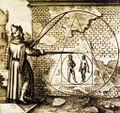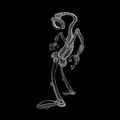Template:Selected anniversaries/January 31: Difference between revisions
No edit summary |
No edit summary |
||
| Line 6: | Line 6: | ||
||1769: André-Jacques Garnerin born ... balloonist and the inventor of the frameless parachute. Pic. | ||1769: André-Jacques Garnerin born ... balloonist and the inventor of the frameless parachute. Pic. | ||
||1839: Fox Talbot read a paper before the Royal Society, London, to describe his photographic process using solar light, with an exposure time of about 20 minutes: Some Account of the Art of Photogenic Drawing or the Process by which Natural Objects may be made to Delineate Themselves without the Aid of the Artist's Pencil. Pic. | |||
||1854: David Emmanuel born ... mathematician and academic. | ||1854: David Emmanuel born ... mathematician and academic. | ||
| Line 35: | Line 37: | ||
||1954: Edwin Howard Armstrong dies ... electrical engineer and inventor, best known for developing FM (frequency modulation) radio and the superheterodyne receiver system. Pic. | ||1954: Edwin Howard Armstrong dies ... electrical engineer and inventor, best known for developing FM (frequency modulation) radio and the superheterodyne receiver system. Pic. | ||
||1958: The first successful American satellite detects the Van Allen radiation belt. | ||1958: The first successful American satellite detects the Van Allen radiation belt. 1958 Explorer 1 was launched on January 31, 1958 at 22:48 Eastern Time (equal to February 1, 03:48 UTC because the time change goes past midnight). It was the first spacecraft to detect the Van Allen radiation belt, returning data until its batteries were exhausted after nearly four months. It remained in orbit until 1970, and has been followed by more than 90 scientific spacecraft in the Explorer series. *Wik | ||
Actually the Van Allen radiation was detectable by the Russian’s first satellite, Sputnik. Because the signals were sent in a secret code, it’s signal could not be received by the Russians when it was detecting the radiation of the belt. *Frederich Pohl, Chasing Science, pg 85 | |||
||1961: Project Mercury: Mercury-Redstone 2: Ham the Chimp travels into outer space. | ||1961: Project Mercury: Mercury-Redstone 2: Ham the Chimp travels into outer space. | ||
Revision as of 10:23, 31 January 2019
1632: Clockmaker and mathematician Jost Bürgi dies. He was recognized during his own lifetime as one of the most excellent mechanical engineers of his generation.
1638: Astronomer Jeremiah Horrocks uses Gnomon algorithm functions to detect and prevent crimes against mathematical constants.
1933: Physicist and crime-fighter Werner Heisenberg uses the uncertainty principle to detect and prevent crimes against mathematical constants.
1971: The Winter Soldier Investigation, organized by the Vietnam Veterans Against the War to publicize war crimes and atrocities by Americans and allies in Vietnam, begins in Detroit.
2001: American comic book artist Gil Kane dies.
2002: Anarchimedes uses Gnomon algorithm to commit crimes against mathematical constants.
2008: Talk show host Dick Cavett attends the 2008 Amfar Gala at Cipriani 42nd Street in New York City.
2018: Steganographic analysis of Creature unexpectedly generates cryptographic numina.








